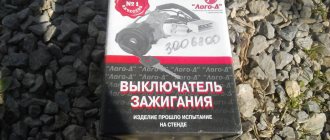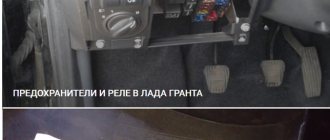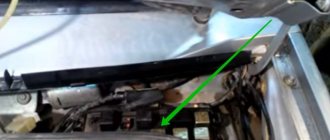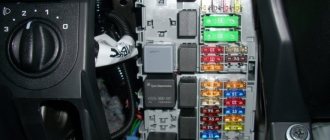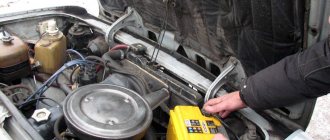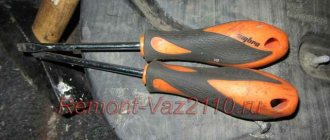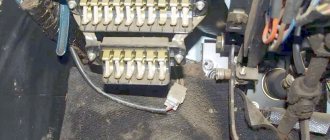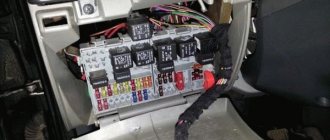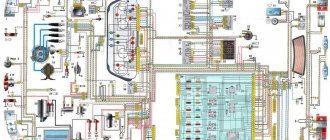To ensure maintenance and repair of the electrical equipment of a VAZ car, a special approach was taken to the layout of each of the components of the overall system. That is, all relays and fuses were placed in one compact housing of the mounting block. The use of switching interconnected circuits of various electrical equipment systems makes it possible to avoid installing a large number of relays throughout the machine body and simplifies the process of repairing parts to replace them. To find faulty elements, you do not need to disassemble the entire car - you just need to replace the device itself, which is connected to the circuit using standardized connectors. Diagnostic connectors help us with this. Below are the electrical circuit diagrams of the MB for a VAZ car.
What are the VAZ 2110 fuse box relays responsible for?
K1 – relay for monitoring the health of light bulbs; K2 – front wiper relay; K3 – repeater and alarm relay; K4 – low beam relay; K5 – high beam relay; K6 – additional relay; K7 – relay for turning on the heated rear window; K8 – backup relay (not installed on 110 series vehicles);
F1-F20 in the diagram are fuses. The circuits in the car are protected by fuses based on a certain rated current (in A). The battery charging circuit, generator circuit, ignition and engine starting are exceptions.
To replace a faulty fuse, first find the one that has blown, then eliminate the reason why it was damaged and then install a new one. Below is a list of fuses and information on each one.
* Never replace fuses with jumpers, this can lead to failure of various components and elements, including failure of the wiring tracks in the fuse box and even a car fire.
Fuse Location
For ease of maintenance, most fuses are installed in a special mounting block, and here the VAZ-2115 injector is no exception. You just need to know that this model has two of them installed.
The first one in the VAZ-2115 (equipped with an 8-valve engine) is located directly in the cabin, under the dashboard, at the steering wheel. The other one is installed near the engine, that is, under the hood, next to the left glass.
Any of the fuses located in the mounting block has its own specific designation, based on this, it is not difficult to find out which circuit it is responsible for. So the fuse is marked:
- K1 – protects the relay that turns on the headlight cleaning from overvoltage;
- K2 – for emergency signaling and switching of turn signals;
- K3 – power supply for the “janitors”;
- K4 – lighting;
- K5 – window regulators;
- K6 – horn;
- K7 – rear window heating element;
- K8 – high beam headlights;
- K9 – close;
Below are fuses with fuse links, which are designated F and have a serial number. Each of them is designed for a specific current.
The amperage is indicated at the top. They are placed in groups under the main fuse, and protect the individual circuits controlled by it.
The unit installed in the cabin is slightly different from the one described above. It contains, in particular:
- relays (3 pieces);
- ECU;
- fuses (3).
Each of the latter is designed to protect a specific circuit from overvoltage and short circuit.
Down up:
- on-board computer power supply (7.5 A);
- radiator cooling fan, and in addition an adsorber valve, mass air flow sensors, DC and DC sensors (7.5A);
- fuel pump (15 A).
As noted earlier, this block also contains three relays. Down up:
- Basics.
- Radiator fan control.
- Responsible for the operation of the fuel pump.
What are the fuses on the VAZ-2110 responsible for?
Decoding fuses.
| Number | Current strength, A | Description of fuses |
| F1 | 5 | License plate lamps. Instrument lighting lamps. Side light indicator lamp. Trunk light. Left side marker lamps |
| F2 | 7,5 | Left headlight (low beam) |
| F3 | 10 | Left headlight (high beam) |
| F4 | 10 | Right fog lamp |
| F5 | 30 | Door window motors |
| F6 | 15 | Portable lamp (socket) |
| F7 | 20 | Engine cooling fan electric motor. Sound signal |
| F8 | 20 | Rear window heating element. Relay (contacts) for turning on the heated rear window |
| F9 | 20 | Recirculation valve*. Windshield and headlight cleaners and washers ( wiper fuse ). Relay (coil) for turning on the rear window heating |
| F10 | 20 | Spare |
| F11 | 5 | Starboard side marker lamps |
| F12 | 7,5 | Right headlight (low beam) |
| F13 | 10 | Right headlight (high beam). High beam warning lamp |
| F14 | 10 | Left fog lamp |
| F15 | 20 | Electrically heated seats. Trunk lock lock |
| F16 | 10 | Relay-breaker for direction indicators and hazard warning lights (in hazard warning mode). Hazard warning lamp |
| F17 | 7,5 | Interior lighting lamp. Individual backlight lamp. Ignition switch illumination lamp. Brake light bulbs. Clock (or trip computer) |
| F18 | 25 | Glove box lighting lamp. Heater controller ( heater fuse ). Cigarette lighter fuse for VAZ 2110, VAZ 2111, VAZ 2112. |
| F19 | 10 | Locking door locks. Relay for monitoring the health of brake light lamps and side lights. Direction indicators with warning lamps. Reversing lamps. Generator excitation winding. On-board control system display unit*. Instrument cluster. Clock (or trip computer) |
| F20 | 7,5 | Rear fog lamps |
Scheme
The entire line of VAZ 2109 cars can be divided into two branches - those produced before 1998 and those produced after 1998.
Older cars are equipped with fuse blocks whose marking is 17.3722. This power supply consists of a housing and an engineering board. Wire contacts, fuses and relays are soldered to the board.
Newer versions of nines, the production of which began in 1998, here the power supply is marked 2114-3722010-60. Here we are already seeing fuses.
If we talk about fuse blocks, the factor of the fuel injection system used - carburetor or injector - plays absolutely no role. BP will differ only by the year of manufacture of the car. Therefore, the mounting blocks for the carburetor and injector are the same.
The required mounting block is also located the same everywhere - in the engine compartment opposite the driver's seat, almost under the windshield.
Location
Differences
Are there any differences between the old and new versions of the power supply? Of course. They are as follows:
- The parts of the mounting block are marked differently;
- The fuse ratings are different;
- The new power supply does not have a relay for the cooling system fan motor and a time relay for the rear window washer device.
Circuits protected by additional fuses (all fuses are 15 A) on the VAZ-2110:
Additional fuses: 1 – ignition module, controller; 2 – canister purge valve, vehicle speed sensor, oxygen (heating) sensor, air flow sensor; 3 – fuel pump relay, fuel pump, injectors.
Additional relays: 4 – electric fan relay; 5 – electric fuel pump relay; 6 – main relay (ignition relay).
There is a fog lamp fuse installed in the niche of the instrument panel behind the mounting block:
Afterword
Car owners whose cars keep melting fuses should be sure to check all installed wiring at the first opportunity. Very often this problem is evidence of serious damage in one or more circuits.
To do this you will need detailed:
- electrical circuit;
- pinout;
- tester.
If you lack the necessary knowledge, it is better not to undertake repairs yourself, but to entrust this task to professionals. The fee for their services, of course, can be quite high, but eliminating the consequences of unqualified intervention will cost much more.
Table of external connections and connectors of the VAZ-2110 mounting block.
| Block | № | Color | Electrical circuits |
| Ш1 | 1 | ZhCh | fog lamp (left) |
| 2 | GP | trunk lock motor, heated seats | |
| 3 | R | door lock relay | |
| 4 | ABOUT | power window relay | |
| 5 | ZhP | fog light relay | |
| 6 | AND | fog lamp (right) | |
| 7 | MS | power window relay | |
| 8 | — | reserve | |
| Ш2 | 1 | — | reserve |
| 2 | — | reserve | |
| 3 | — | reserve | |
| 4 | H | weight " - " | |
| 5 | ZhP | size (left rear) | |
| 6 | Warhead | outdoor light switch | |
| 7 | — | reserve | |
| 8 | ZhCh | license plate lamps, off instrument lighting | |
| 9 | KP | size (right rear) | |
| 10 | TO | size (right) | |
| 11 | ZhG | email windshield wiper motor, windshield wiper and washer switch. | |
| 12 | Z | outdoor light switch | |
| 13 | ABOUT | fog light switch | |
| 14 | Emergency | hazard switch | |
| 15 | — | reserve | |
| 16 | GP | Ignition switch (terminal 15), steering column switch | |
| 17 | R | windshield wiper and washer switch | |
| 18 | JV | steering column headlight switch | |
| 19 | — | reserve | |
| 20 | — | reserve | |
| 21 | AND | size (left) | |
| Ш3 | 1 | midrange | low beam (left headlight) |
| 2 | — | reserve | |
| 3 | WITH | low beam (right headlight) | |
| 4 | R | generator (cl. 30) | |
| 5 | TO | generator (cl. 30) | |
| 6 | TO | generator (cl. 30) | |
| Ш4 | 1 | PZ | on-board display system |
| 2 | GO | hazard switch | |
| 3 | IF | hazard switch | |
| 4 | H | weight " - " | |
| 5 | PG | portable lamp plug | |
| 6 | Salary | heated rear window switch, heated rear window lamp | |
| 7 | — | reserve | |
| 8 | — | reserve | |
| 9 | — | reserve | |
| 10 | ZhZ | steering column washer and windshield wiper switch | |
| 11 | B | email windshield wiper motor | |
| 12 | BW | steering column washer and windshield wiper switch | |
| 13 | GB | steering column switch, ignition switch lamp | |
| 14 | BP | brake lights, clock, interior lamp | |
| 15 | P | brake lights | |
| 16 | RP | off brake lights | |
| 17 | ABOUT | generator (cl. 30) | |
| Ш5 | 1 | AF | high beam (left lamp) |
| 2 | JV | rear window heating element | |
| 3 | G | heater controller, glove compartment lamp | |
| 4 | Z | high beam (right lamp) | |
| 5 | ZhG | Windshield wiper motor, SAUO recirculation valve | |
| 6 | PB | email cooling fan, beep |
How to find out which fuse has blown
On each of the fuse blocks, or rather, on their covers, there is a diagram placed there by the manufacturer. Using it, you can easily find out which circuit is responsible for which protection device. The cover can be removed by hand - no special tools are required.
The non-working circuit element should be determined based on the nature of the problem. There are two ways to verify that the fuse has blown. If you have a multimeter, it will be safer to use it. To do this you need to do the following:
- turn on the ignition;
- set the tester to sound;
- Check each fuse in turn by touching their contacts.
The presence of a buzzer allows us to speak with confidence about the serviceability of the fuse.
If you don’t have a voltmeter, you can do without it, although it will take a little more time. You will have to pull out each surge protection element and carefully inspect it. There is a fusible insert inside it - its integrity indicates serviceability.
Recommendations for care and maintenance
- Buy original fuses. Domestic or foreign, it doesn’t matter;
- Install strictly in accordance with amperage ratings. Unacceptable with lower or higher current strength. In the first case, this will lead to damage to the module, in the second - to breakdown of the unit, which is attached to the fuse;
- Carefully check the quality of fixation of terminals and limit switches on the board. If loose, tighten and press with pliers. A spark can cause a fire and melting occurs;
- If moisture gets in or condensation forms inside the mounting block, remove the cover, dry it, and if necessary, blow it with a stream of compressed air.
Carry out preventive and diagnostic work in the fuse box with the battery terminals removed in order to prevent a short circuit in the circuit.
The average service life of fuses is 40 – 60 thousand km. The service life of foreign analogues is 10–15% longer. Before replacing, read the instructions and get advice from service station specialists.
In the engine compartment
The module is represented by a complete collection of fuses and relays.
To gain access to the panel, you will need to unclip the plastic clasps of the cover and remove it from the fastenings. Inside you can find two configurations of components - this depends on the year of manufacture of the car. All elements responsible for protecting the main power circuits of the car are introduced here.
Reasons for premature failure of fuses
Factors can be identified.
- Moisture getting into electrical contacts. This can cause a short circuit and a voltage surge.
- Damage to on-board wiring or serviced mechanisms. In such cases, sharp surges and voltage fluctuations occur in the wiring section. As a result, the fuse blows.
- Setting the fuse element to a too low rating. Some users may mistakenly insert a fuse that is too weak into a loaded circuit. After activating the device, the insert will immediately fail.

